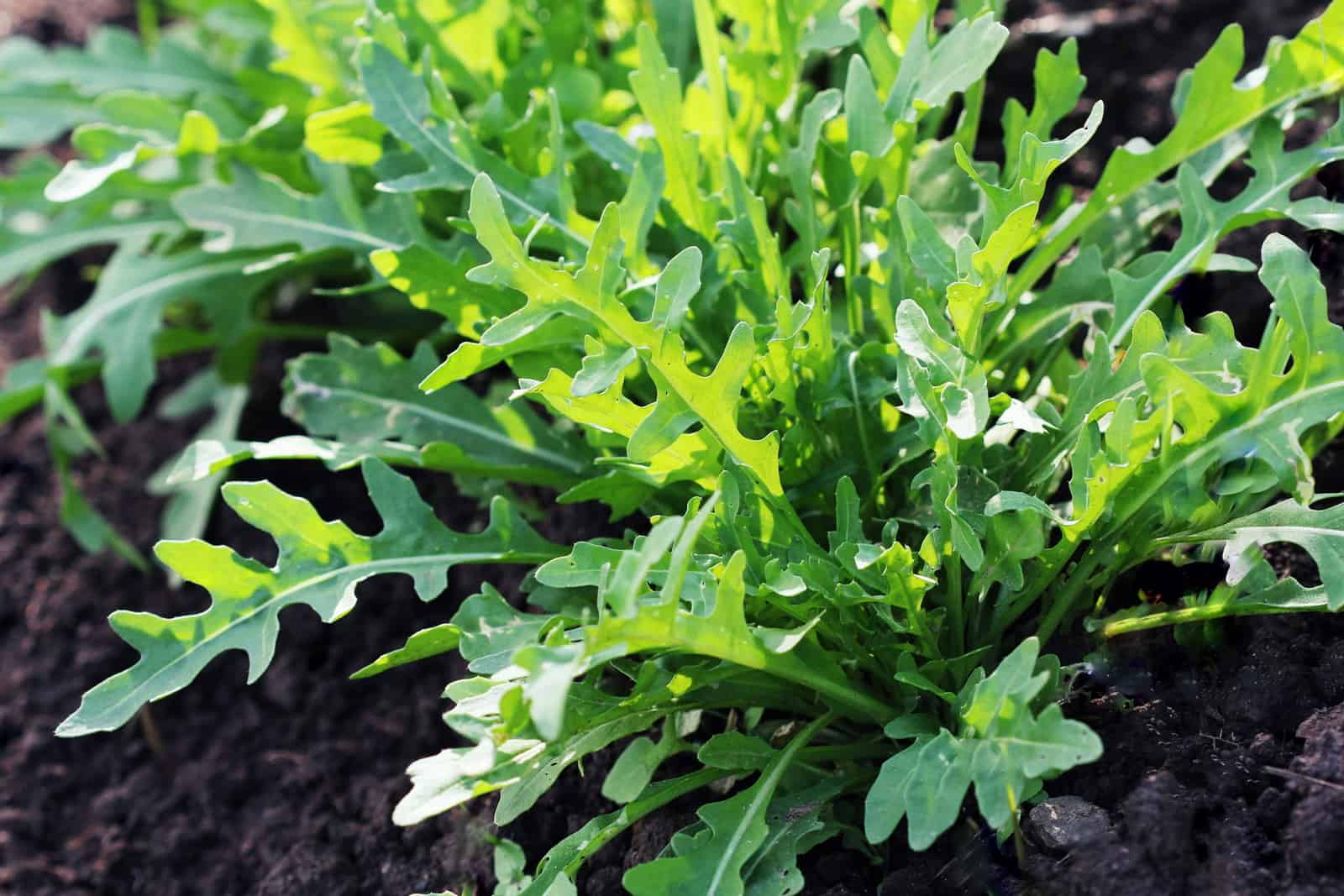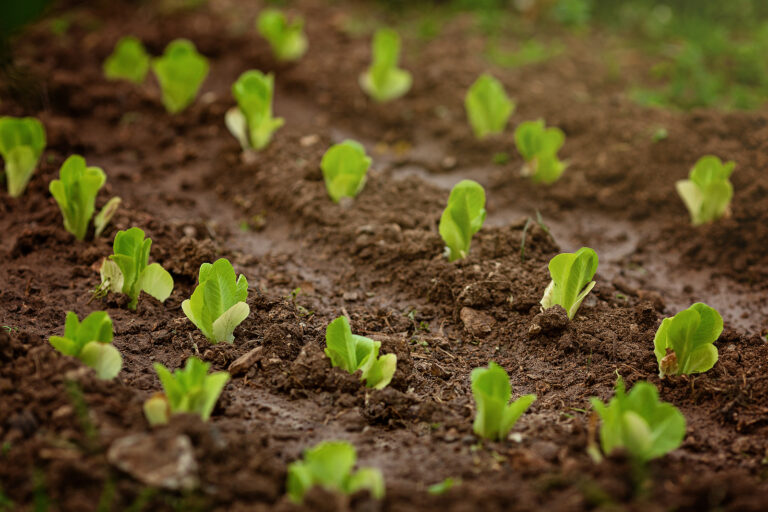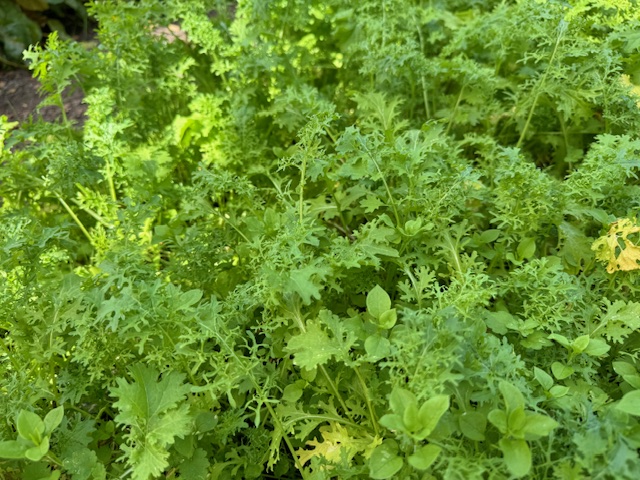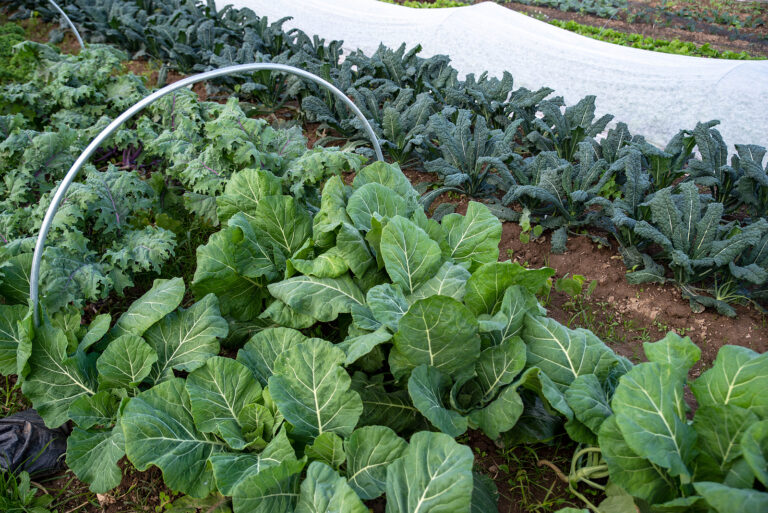The Ultimate Arugula Growing Guide: From Seed to Harvest
Arugula–also known as rocket, garden rocket, and roquette–is a dense, low-growing plant with long, smooth, soft-lobed, bright green leaves. Arugula is a cool-weather leafy crop. Grow arugula in spring and autumn. Arugula leaves can be harvested about six weeks after sowing seeds. Arugula plants will continue to produce succulent leaves as long as the weather stays cool.
Arugula is an annual but can be treated as a perennial because it so readily self-sows. When warm weather comes, arugula will produce white or yellow flowers and quickly drop seeds, and self-sow for the next season. (Arugula’s quick self-sowing and growth led to the common name rocket). Plants not harmed by winter cold will produce flavorful leaves for about three years.
Related articles:
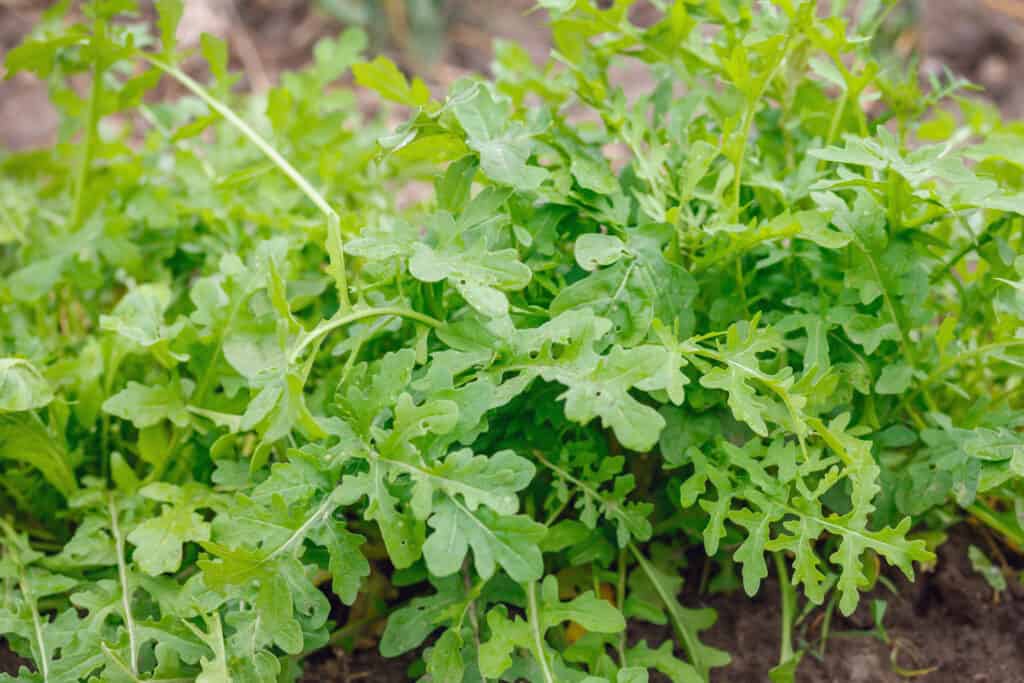
Arugula has a spicy flavor and is used in small quantities to add flavor to pesto, salads, and sandwiches–much like its cousin mustard. Arugula is a Mediterranean native and is a popular salad green in southern Europe and Egypt. For a steady supply of the most tender leaves, it’s best to sow seed every few 7 to 10 days and keep picking young leaves and plants.
Here is your complete guide to growing arugula.
Arugula Quick Growing Tips
- Arugula is a cool-weather crop.
- Sow arugula seed in the garden as early as 2 to 3 weeks before the average date of the last frost in spring.
- Grow arugula in temperatures ranging from 45° to 65°F (10-18°C).
- Arugula will germinate in soil temperatures as low as 40°F. Sow arugula in spring as soon as the soil can be worked.
- Plant arugula so that it comes to harvest in cool weather. Arugula will not grow well in summer except in Zones 4 and colder regions.
- Sow succession arugula crops every 2 to 3 weeks for a continuous harvest.
- If summers do not get very warm, continue planting until about a month before the average first frost date.
- In hot summer regions, where winters are mild, plant arugula in late autumn for harvest in winter and spring.
- Yield. Grow 5 to 6 arugula plants per household member.
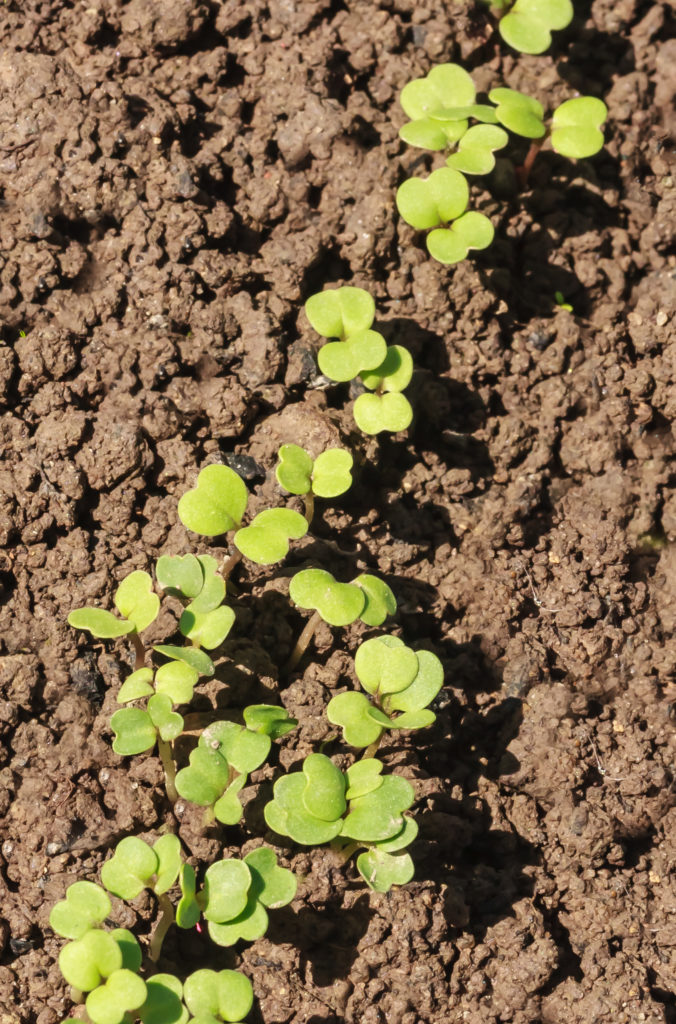
Where to Plant Arugula
- Grow arugula in full sun; arugula will tolerate partial shade. It can be grown easily in USDA Zones 3-11.
- Plant arugula in rich soil that includes plenty of organic matter. Add aged garden compost to planting beds before growing. Spread a 1-inch (2.5-cm) layer of compost over the planting area and work it in. Rake the bed smoothly to remove clumps before sowing seeds.
- Give arugula afternoon shade if temperatures get warm toward the end of spring.
- Arugula prefers a soil pH of 6.0 to 7.0.
- Undercropping: Arugula is quick-growing to maturity; it can be grown in bands between and around slow-maturing brassicas (cabbage family crops).
- Indoor growing: Arugula can be grown indoors in seed trays or small pots under a grow light or in a bright window; small seedlings can be harvested for adding to salads and sandwiches. Arugula seedlings are among the most nutritious microgreens. Arugula is a very good addition to indoor gardens.
Arugula Planting Time
- Arugula is a hardy, cool-season annual.
- Grow arugula can be planted in early spring as soon as the soil can be worked for late spring and early summer harvest; it can be planted in late summer or early fall for a fall harvest. A key to success is to grow arugula in cooler weather.
- Grow arugula in fall and winter in warm-winter regions.
- Sow arugula seeds in the garden as soon as the soil can be worked in spring, usually 2 to 3 weeks before the average date of the last frost in spring.
- Grow arugula in temperatures ranging from 45° to 65°F (10-18°C). Cool temperatures produce the sweetest-tasting arugula.
- For the best flavor and to avoid bolting, plant arugula so that it comes to harvest in cool weather.
- Arugula requires about 40 days to come to harvest depending upon the variety. The short growing time to edible size makes arugula a great crop for cool season succession planting.
- Arugula can be grown in summer in Zones 4 and colder regions; in summer sow arugula in the shade of taller crops.
- Grow heat-resistant cultivars in summer (see list below). Non-heat-resistant cultivars will bolt (produce flowers and seeds) at about 70°F.
- In all regions, arugula can be grown through the winter in a cold frame.
- Arugula can survive light frosts; grow arugula undercover in a cold frame or plastic tunnel once freezing temperatures arrive.

Arugula Planting and Spacing
- Sow arugula seed ¼ inch (6mm) deep and 1 to 2 inches apart (2.5-5 cm) to start.
- Arugula seed is very small; seeds are easily broadcast by placing seeds in the palm of the hand and then rubbing the hands together.
- Thin plants to 6 inches (15 cm) apart when the seedlings are 4 inches (10 cm) tall. You can eat the thinnings–baby arugula greens in salads and use them as a garnish.
- Space rows 6 to 18 inches (15-45 cm) apart.
- You can also broadcast arugula seed with other greens and harvest leaves when small.
- Intensive spacing: Sow seeds lightly in a band 2 to 4 inches (5-10cm) wide.
- Arugula yield: Sow 1 to 2 feet (30-60cm) of row per person, about 9 to 16 plants per square foot.
More tips at Arugula Seed Starting Tips.
Companion Plants for Arugula
- Grow arugula is a good companion to other greens. Arugula has a shallow root system and can be grown between other members of the mustard family or under other leafy vegetables.
- Planting arugula in bands under or among slower-growing crops is a good strategy.
- Avoid growing arugula with peas, beans, or strawberries.
- Arugula is a good choice for intercropping with larger crops.
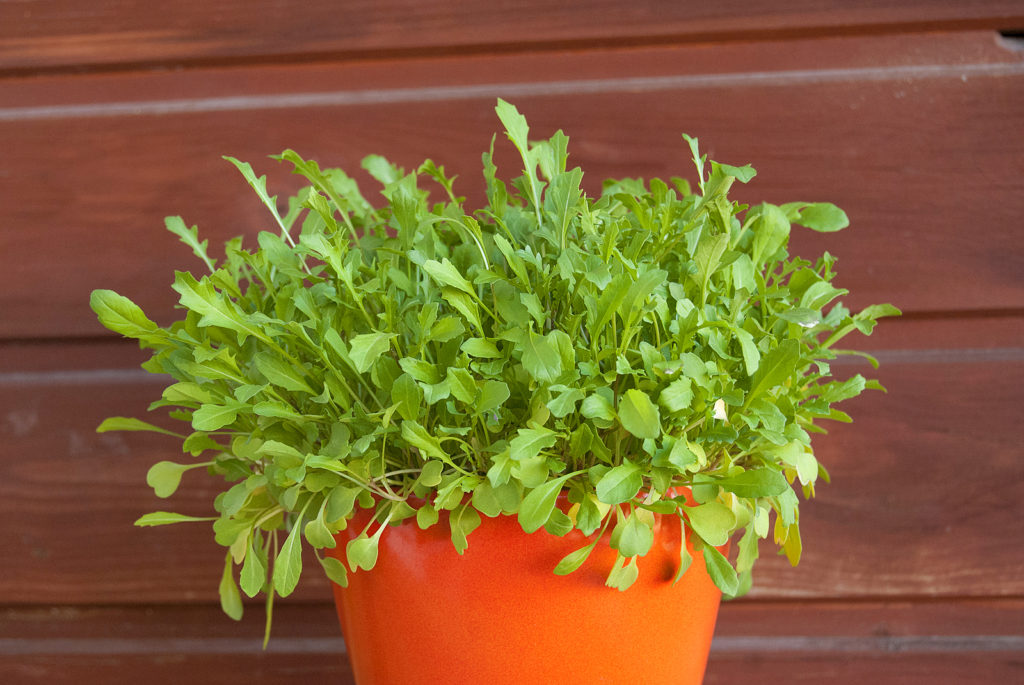
Container Growing Arugula
- Arugula can be grown in a container. Choose a container at least 6 inches deep to accommodate the roots.
- Arugula has a shallow root system so it is a good choice for pots and other containers and for raised beds.
Watering and Feeding Arugula
- Keep the arugula planting area evenly moist.
- Water arugula regularly to prevent the flavor from becoming too strong or hot.
- In arid regions, use overhead irrigation to prevent the leaves from drying in dry heat.
- Add aged compost to planting beds before planting and again at midseason.
Arugula Care
- Keep arugula plants cut back to about 10 inches tall. Arugula can grow to 24 inches tall but the leaves will be too bitter to eat.
- Cutting arugula back (as you would Swiss chard) will not hurt the plant; cutting arugula back will encourage new young leaves to grow.
- Once the flavor of the leaves turns bitter, pull out the plants and turn to new plantings.
- Allow a few plants to go to flower. The flowers are edible and the seeds will self-sow.
Arugula Pests
- Flea beetles often attack arugula leaving tiny holes in the leaves; cover plants with a floating row cover. Use yellow sticky traps to help control pests.
- Cabbage loopers — cabbage worms are small green caterpillars that chew ragged holes in leaves; crush yellow eggs laid on the undersides of leaves; handpick or sprinkle plants with diatomaceous earth; floating row covers will exclude butterflies with two or three black spots on each wing that lay eggs; spray with Bacillus thuringiensis (a beneficial bacterium).
- Slugs and snails eat large holes in leaves; spread diatomaceous earth around the plants which injure and kills these mollusks.
Arugula Diseases
- Downy mildew is a fungal disease that results in yellow angular spots on leaves that turn brown spots; a white-gray-purple cottony growth develops on the undersides of leaves; ensure good air circulation and water at the base of plants avoiding overcrowding; plant resistant varieties.
- White rust is a fungus that creates chalk-white blisters on the undersides of leaves; yellow blisters may appear on the top of leaves; destroy infected plants, rotate crops, and plant disease-resistant varieties.
- Leaf blight is a bacterial disease that causes leaves to yellow and brown; remove infected plants and avoid overhead watering.
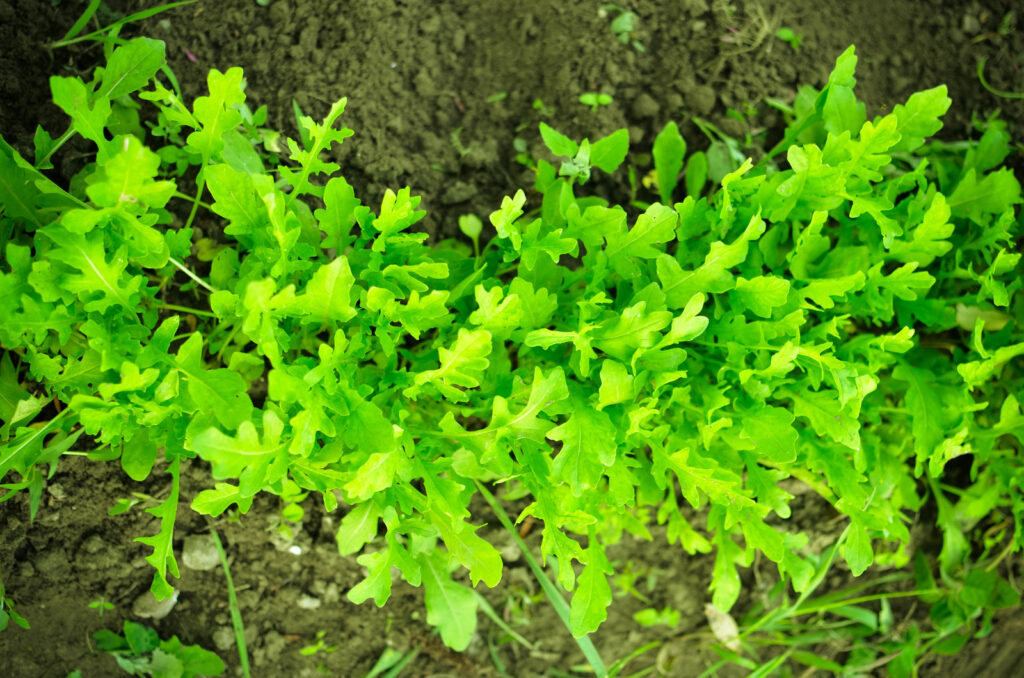
Harvesting Arugula
- Mature arugula leaves are ready for harvest 40 days after sowing; baby leaves can be harvested 21 to 28 days after sowing; microgreens can be harvested 14 days after sowing.
- Pick young, tender leaves when they are when they are 2 to 5 inches (5-7.5 cm) long.
- Use a pair of sharp scissors to snip off leaves 1 inch (2.5cm) above the soil.
- Harvest arugula in the morning when the leaves are full of moisture.
- An arugula plant can be harvested cut-and-come-again four times before plants run to seed.
- Leaves that grow to more than 10 inches high can quickly become bitter and spicy hot.
- Pick new leaves from the bottom, outside of the plant. New leaves will sprout from the center crown.
- Wash arugula leaves by swishing them in a bowl of cool water. The leaves may require three or more washings to remove all traces of soil.
- Harvest whole plants by pulling out plants or cutting the whole plant just above the roots.
- Older leaves are more bitter-flavored than young leaves.
More on arugula harvest and storage at How to Harvest and Store Arugula.
Storing and Preserving Arugula
- For the best flavor and texture, use arugula immediately after picking.
- If you want to refrigerate arugula, wash and dry the leaves thoroughly and wrap them in a paper towel or cloth then place them in a perforated plastic bag in the refrigerator crisper drawer.
- Arugula will keep in the refrigerator for just a few days.
- Chopped arugula mixed with olive oil can be frozen in ice cube trays; the cubes can be used in soups and sautés.
- Arugula pesto can be frozen.
- Use arugula fresh for the best flavor.
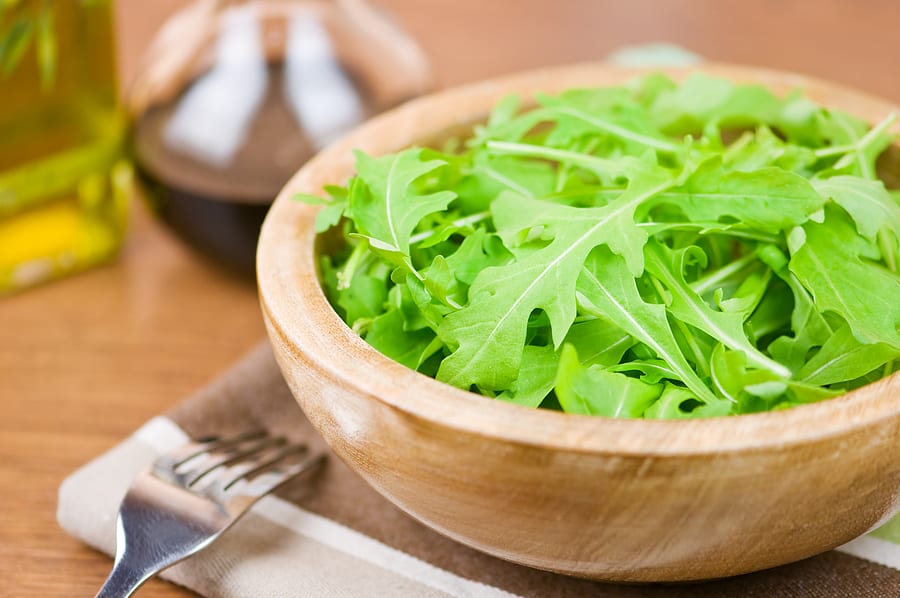
Arugula in the Kitchen
- Arugula is a flavoring salad ingredient; it is not a stand-alone salad green. Use arugula to add a spicy note to salads.
- Young arugula leaves have a nutty or tangy flavor; the flavor becomes more peppery and more piquant as the plants grow or the temperature rises.
- Young arugula leaves are the most tender and flavorful; older leaves become tough and stringy and very strong flavor.
- Use fresh-cut arugula in salads or pesto, or saute it lightly.
- Add arugula leaves to sandwiches and wraps.
- Arugula is often added to mesclun salad mixes.
- Arugula flowers are edible.
- Serve arugula with hummus and with feta cheese.
- Add arugula to quiche, soups, and tomato dishes.
- Italians saute arugula and then mix it in with pasta.
- Use arugula to make pesto.
- Boiled and pureed arugula can be combined with sour cream and herbs for a dip.
Arugula Propagation
- Arugula readily self-sows. Allow some plants to flower and drop seeds.
- Let seedlings spring up where you want them or gently lift them for transplanting.
Arugula Varieties to Grow
Arugula is available in several varieties. There are two types of arugula; garden arugula and wild arugula commonly called wild rocket. These two types are different species. Garden arugula is Eruca sativa or Eruca vesicaria; wild arugula is Diplotaxis tenuifolia. These two species are grown in the same way. Garden arugula is generally smaller and milder flavor. Wild arugula (wild rocket) is taller, weedier looking, and spicier.
Garden Arugula Varieties
- ‘Astro’ fast-growing cultivar with a mild, peppery flavor; harvest mature leaves in about 30 to 40 days; the flowers are edible; heat-tolerant; small leaves are ready in 20 days.
- ‘Garden Tangy’ has small leaves; good heat resistance; is often grown in Italy and Mediterranean climates; harvested in 30 to 35 days.
- ‘Italian Cress’ produces large leaves well-suited for salads or for soups and sautees.
- ‘Italian Rocket’ also known as “Italian Wild Rustic’ has finely cut leaves and a sharp flavor.
- ‘Red Dragon’ oak-shaped, toothed leaves with re to maroon veins; grows best in cooler weather; slow growing; matures in about 45 days.
- ‘Rocket’ is a very popular classic supermarket variety with serrated leaves; best planted in cool temperatures of spring or autumn; matures in about 40 days.
- ‘Runway’
- ‘Slow Bolt’ open-pollinated heirloom with broad lobed leaves; spicy, peppery flavor; bred to resist bolting–slow to bolt in warm weather; matures in about 43 days.
- ‘Sylvetta’ or ‘Selvactica’ produces small leaves; it is slow to bolt; matures in about 30 days.
- ‘Wall-Rocket’ grows well in warm weather; it is a good choice for southern gardeners.
- ‘Wasabi’ is an extra-spicy variety; good with Asian-inspired dishes; frost hardy.
Wild Rocket Varieties
Wild rocket is a different species of plant than those listed above. The botanical name of wild rocket is Diplotaxis tenuifolia.
- ‘Wild Rocket’ is a perennial variety with a weedy look and strong spicy flavor; matures in about 50 days; heat tolerant.
- ‘Bellezia Arugula’ heirloom variety often grown by market growers; uniform leaves; heat tolerant and slow to bolt; matures in about 50 days.
- ‘Wildfire Rocket’ distinctly sharp flavor; matures in about 45 days.
About Arugula
- Common name. Arugula, rocket, garden rocket, rucola, roquette, rucoli, arugula, Mediterranean salad.
- Botanical name. Erica sativa, Eruca vesicaria; wild rocket botanical name Diplotaxis tenuifolia.
- Botanical family: Brassicaceae (other members of this family are kale, broccoli, cauliflower, and mustard)
- Origin. Southern Europe and Western Asia
- Arugula has been in cultivation since at least the 6th century BC. It is used medicinally in India, Pakistan, and West Asia. Oil pressed from arugula seeds is called Taramina oil.
- Arugula is very popular in Italy, Morocco, Turkey, and Portugal.)
- Turkish rocket resembles arugula but is a different plant, Bunias orientalis. Strains of arugula are sometimes sold as Turkish rocket.
Arugula Growing Hub
Start here: The Ultimate Arugula Growing Guide: From Seed to Harvest
Planting & Site Prep
- When to Plant Arugula by USDA Zone
- Arugula Seed Starting Tips
- How to Plant and Space Arugula for Maximum Yield
- The Best Companion Plants for Arugula and What to Avoid
- How to Grow Arugula in Containers or Pots
Care & Maintenance
- How to Water Arugula for Tender Leaves
- Fertilizing Arugula: Feeding Tips for Fast Growth
- How to Care for Arugula Throughout the Growing Season
Pests & Diseases
Harvest & Storage
Varieties
Kitchen & Extra Uses
How to Prepare and Serve Arugula
Arugula articles at Harvest to Table:
How to Plant and Grow Arugula – Rocket
How to Harvest and Store Arugula
How to Prepare and Serve Arugula
Learn how to plant, grow, and harvest your favorite kitchen herbs. Click below for all you need to know about culinary herbs.
- Anise
- Anise Hyssop
- Arugula
- Basil
- Bay
- Bee Balm
- Borage
- Calendula
- Caraway
- Catnip
- Chamomile
- Chervil
- Chives
- Cilantro-Coriander
- Clary
- Costmary
- Cress
- Dill
- Fennel, Sweet
- Horseradish
- Hyssop
- Lavender
- Lemon Balm
- Lemon Verbena
- Lovage
- Marjoram
- Mint
- Nasturtium
- Oregano
- Parsley
- Perilla
- Rosemary
- Sage
- Salad Burnet
- Savory
- Scented Geranium
- Shiso
- Sorrel
- Stevia
- Sweet Cicely
- Tarragon
- Thyme
Articles of interest:
Best Herbs for Container Growing
Garden Planning Books at Amazon:

